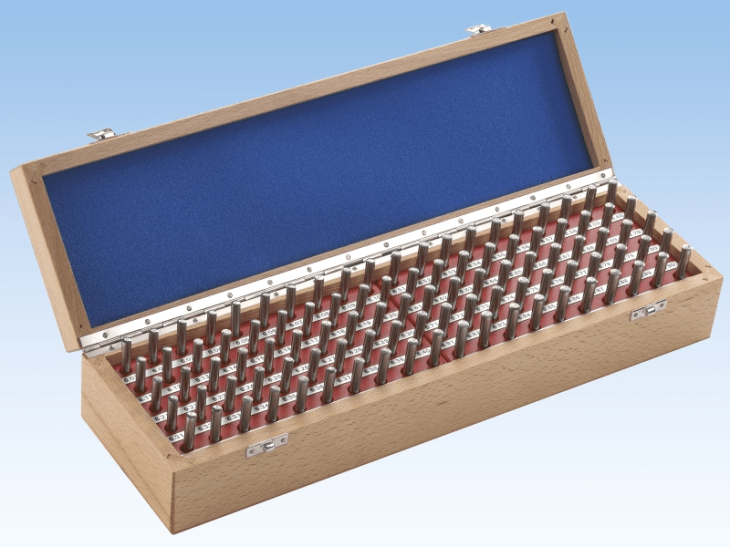Plug and Pin Gages Information
 Plug and pin gages are used to compare hole and slot dimensions or locations to specific tolerances. There are several basic types of products. Go gages and no-go gages are fixed-limit gages with gauging limits based on the plus or minus tolerances of inspected parts. Go gage dimensions are based on the minimum inside diameter (ID) tolerance of the inspected part. No-go gage dimensions are based on the minimum outside diameter (OD) tolerance of the inspected part. Double-ended go/no-go gages include a go gage pin on one end of a handle and a no-go gage pin on the opposite end. Progressive or step go/no-go gages have stepped pins with the go gage surface and the no-go gage surface on the same side of the handle. Master gage blocks, master or setting discs, and setting rings are master gages used to calibrate or set working plug or pin gages. Working devices are used for dimensional inspection and checked periodically against a master gage. Annular plug gages are large, usually over 8 in. in diameter, and used to set or check micrometer or other OD gages. Some plug and pin gages have internal or external threads for gauging thread parts or part features. Others are packaged in a kit with adjustment tools such as alternate extensions and contact tips, holders, and bases.
Plug and pin gages are used to compare hole and slot dimensions or locations to specific tolerances. There are several basic types of products. Go gages and no-go gages are fixed-limit gages with gauging limits based on the plus or minus tolerances of inspected parts. Go gage dimensions are based on the minimum inside diameter (ID) tolerance of the inspected part. No-go gage dimensions are based on the minimum outside diameter (OD) tolerance of the inspected part. Double-ended go/no-go gages include a go gage pin on one end of a handle and a no-go gage pin on the opposite end. Progressive or step go/no-go gages have stepped pins with the go gage surface and the no-go gage surface on the same side of the handle. Master gage blocks, master or setting discs, and setting rings are master gages used to calibrate or set working plug or pin gages. Working devices are used for dimensional inspection and checked periodically against a master gage. Annular plug gages are large, usually over 8 in. in diameter, and used to set or check micrometer or other OD gages. Some plug and pin gages have internal or external threads for gauging thread parts or part features. Others are packaged in a kit with adjustment tools such as alternate extensions and contact tips, holders, and bases.
Features
Plug and pin gages use several different gauging technologies. Pneumatic systems measure the changes in flow or pressure in air nozzles or inlets located inside air plugs, rings, or snaps. Pneumatic comparators, digital readouts, analog amplifiers, columns, and flowmeter/rotameter tubes are used to display dimensional data. Electronic gages use linear variable differential transformers (LVDTs), capacitive, inductive, or other electronic probes to sense the distance of displacement of a contact or stylus. Mechanical gages use comparison or the physical movement and displacement of a gauging element (e.g., spindle, slide, stem) to determine the dimensions of a part or feature. Examples of mechanical gages include:
- micrometers
- calipers
- indicators
- plug gages
- ring gages
- snap gages
These devices may use an integral electronic probe in addition to the mechanical gauging elements.
Types
There are several geometries and holder/handle types for plug and pin gages. Cylindrical plug and pin gages have a tubular shape and no taper. Tapered devices have a conical form. Pin and plug gages with ball-shaped ends are used to gage spherical cavities and tapered holes. Hex or nut gages have hexagonal or square cross-sections for gauging countersunk holes that lock nut or bolt heads in place during fastening. Plain gages with smoother outer surfaces and bores are also available. There are three holder/handle mounting types. Taperlock gages fit a tapered cavity in the handle. Trilock gages have a central hole for a fastener that attaches the gage to the handle. Reversible gages allowing both ends of a gage to be used. When one end becomes worn, the gage is reversed in the holder. Some devices have heat-insulating, plastic handles.
Specifications
Specifications for plug and pin gages include plug size or diameter, set range, and set steps or increments. Suppliers specify products according to metric or English (imperial) measurements. Tolerance class is an important consideration. Class XX gages range in size from .001 in. to 0.08250 in. and have a tolerance of no more than 0.00002 in. Class X gages range in size from .001 in. to 0.08250 in. and have a tolerance of no more than 0.00004 in. Class Y gages range in size from .001 in. to 0.08250 in. and have a tolerance of no more than 0.00007 in. Class Z gages range in size from .001 in. to 0.08250 in. and have a tolerance of no more than 0.0001 in.
